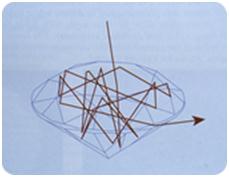When you oooh and ahh over a sparkly diamond, to a large extent you’re reacting to its cut. What you want is light to enter through the crown table (the flat part at the top) and go to the pavilion (the pointy part at the bottom), where it reflects from one side to the other, and then back out of the diamond through the crown table. This ensures maximum sparkle and brilliance. Think spectacular laser show!

If a diamond is not well cut, the light enters through the crown and gets reflected out through the side or bottom. The GIA Diamond Cut Grading System uses a scale of 5 grades: Excellent, Very Good, Good, Fair and Poor to determine the quality of the diamond.
How did GIA create this system? Advanced computer modeling was used to reproduce the way light behaves within a round brilliant cut diamond and predict how a diamond would perform in terms of brightness and fire. GIA analyzed tens of thousands of proportion sets (aka angles and percentages) as well as the effects of polish and symmetry. It turns out that no single proportion, or subset of proportions, can be considered alone.
GIA has calculated the cut results for 38.5 million proportion sets based on the assessment of seven components. The first three — Brightness, Fire, and Scintillation — are appearance-based aspects. The remaining four — Weight Ratio, Durability, Polish, and Symmetry — are related to a diamond’s design and craftsmanship.
Here’s another way to look at it:

In the GIA Diamond Cut Grading System, each component is assessed individually, taking into account the relative importance of that component in the overall cut quality of a round brilliant diamond, and the ability of an average, experienced observer to consistently see the differences in cut quality based on these components.
For more information on the nuances of cut, have a chat with your local, credentialed GIA Graduate Gemologist (G.G.).
Custom Field: Array
